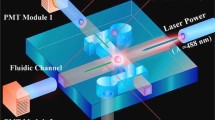Abstract
An optical sensor combined total analysis system (TAS) is thought to be one of the most powerful functional elements needed to realize a “ubiquitous human healthcare” system. In accordance with this concept, we have proposed a fundamental structure of detecting side scattered light from a minute cell or particle running along a microfluidic channel, partially utilizing the channel filled with water or saline solution as a light waveguide. Based on this concept, we have fabricated a trial-manufactured optical TAS chip and carefully evaluated its side scattered light measuring performance in in-plane direction, supplying and detecting visible laser power by using multiple optical fibers and their precise positioning mechanisms. We have successfully obtained experimental results of both transmitted light power change and that of side scattered light, and we confirmed that there was a strong relationship between their signal waveforms. Furthermore, we have developed a hybrid numerical calculation method on the basis of the finite-difference time-domain method, in addition to the beam propagation method. Based on this hybrid method, we tried to compare results between the experimental inverse pulse of transmitted light and a pulse of side scattered light, and those based on numerical calculations. Excellent qualitative accordance was obtained between the inverse pulse of numerical and experimental results. In contrast, the experimental pulse of side scattered light indicated a considerably spread base in comparison to the numerical results.













Similar content being viewed by others
References
Gregor F (2002) Device and method for investigating analysis in liquid suspension or solution. In: international application published under the patent cooperation treaty (PCT), PCT/GB02/05567
Mapps T, Vannahme C, Schelb M, Lemmer U, Mohr J (2009) Design for optimized coupling of organic semiconductor laser light into polymer waveguides for high integrated biophotonic sensors. Microphotonic Eng 86:1499–1501
Ohkubo T, Hashimoto M, Hirota T, Itao K, Niwa T, Maeda H, Mitsuoka Y, Nakajimka K (2000) Mechanical characteristics of an optical flying-head assembly with visible light-wave guide flexure. J Inf Storage Process Syst 2:323–330
Ohkubo T, Terada N, Yoshida Y (2011) Minute particle detection using a light-wave-guide incorporated optical TAS (Total Analysis System). Microsyst Technol 17:849–856
Okagbare PI, Emoey LM, Datta P, Goettert J, Soper SA (2010) Fabrication of cyclic olefin copolymer waveguide embedded in a multi-channel poly(methyl methacrylate) fluidic chip for evanescence excitation. Lab Chip 10:66–73
Takahashi N, Aki A, Ukai T, Nakajima Y, Maekawa T, Hanajiri T (2009) Electrophoretic mobility and resultant zeta potential of an individual cell analyzed by electrophoretic counter method, International Symposium Semiconductor Device Research Symposium (Washington, DC, December 2009), WP4-03
Vazquez RM, Osellame R, Nolli D, Dongre C, Vlekkert Hvd, Ramponi R, Pollnau M, Cellulo G (2009) Integration of femtosecond laser written optical waveguides in a lab-on-chip. Lab Chip 9:91–96
Yamada H, Yoshida Y, Terada N, Hagiwara S, Komatsu T, Terasawa A (2009) Laser fabrication of a micro-fluidic device for a blood cell counter: proceedings of autumn annual meeting. Jpn Soc Precis Eng G64:543–544
Acknowledgments
A part of this research has been supported by the Grant-in-Aid for Scientific Research (category of general research C), sponsored by the Ministry of Education, Culture, Sports, Science and Technology, Japan, since April 2011. A part of this research has been financially supported by a Grant for the Program of the Strategic Research Foundation at Private Universities S1101017, organized by the Ministry of Education, Culture, Sports, Science and Technology, Japan, since April 2011. The authors would also like to thank Dr. Makoto Hikita and Dr. Saburo Imamura, NTT Advanced Technology Corporation, for their useful and valuable technical advice in designing a resin-based light waveguide structure additionally fabricating a 10-μm-sized groove, and for their suggestions concerning a method of precisely observing a transparent light waveguide core structure under the high-magnification optical microscope.
Author information
Authors and Affiliations
Corresponding author
Rights and permissions
About this article
Cite this article
Ohkubo, T., Terada, N. & Yoshida, Y. In-plane detection of scattered light from a minute particle using a resin-based light waveguide incorporated with a microfluidic channel. Microsyst Technol 19, 1319–1328 (2013). https://doi.org/10.1007/s00542-013-1791-2
Received:
Accepted:
Published:
Issue Date:
DOI: https://doi.org/10.1007/s00542-013-1791-2




